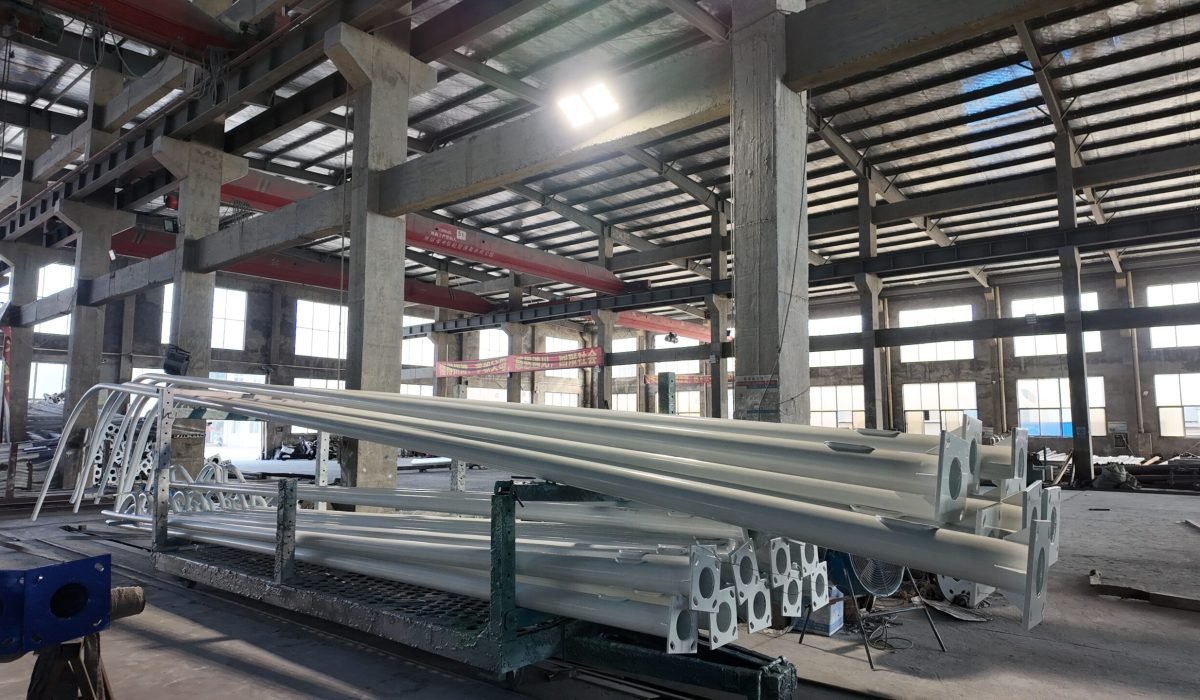1. Why Galvanizing Still Matters for Steel Protection
If you’ve ever walked under an old bridge or past a streetlight that’s stood untouched for decades, you’ve seen the quiet magic of galvanizing. Steel, by nature, wants to rust—it’s its way of returning to iron ore. But that same process destroys structures, silently eating through bolts, poles, and railings.
A coat of zinc changes that story. It’s more than just a shiny finish; it’s a layer that stands between steel and time itself. In cities like Mombasa or Dakar, where humidity and salt hang heavy in the air, unprotected steel lasts only a few years. Galvanized poles, on the other hand, can push past 25 with barely a scratch.
That’s what we’ll explore here—the chemistry, the process, and the reason a bit of zinc can mean decades of reliability.
2. So, What Exactly Is Galvanizing?
In practice, galvanizing means dipping steel into molten zinc until the two metals bond at the surface. The result is a tough, metallic layer that clings like armor.
The most common form is hot-dip galvanizing, though there’s also electro-galvanizing, which uses current, and cold galvanizing, more like painting with zinc-rich material.
Engineers often say, “Zinc takes the damage so steel doesn’t have to.” That’s the essence of it—the zinc forms both a physical barrier and a chemical shield, corroding first and saving the steel underneath.
In other words, the coating doesn’t just cover; it protects by sacrifice.
3. Why Does Steel Rust So Easily?
Before diving deeper into the chemistry, it helps to remember how rust forms in the first place. Steel is mostly iron, and iron reacts easily with oxygen and moisture. When the two meet—especially in salty air or acid rain—the metal begins to transform into iron oxide: rust.
You can spot it near coastlines or industrial zones where humidity, sea spray, and pollution accelerate the reaction.
A corroded base plate or light pole doesn’t just look bad—it weakens the entire structure. A 3 mm layer of rust may not sound much, but it can strip away 30% of strength over time.
That’s why engineers spend more on protection than repainting—because prevention beats repair every single time.
4. How Does Galvanizing Keep Steel From Rusting?
When steel is galvanized, the zinc layer works in two clever ways—one passive, one active.
a. Barrier Protection
Think of it as a raincoat for metal. The zinc coating keeps air and water from ever touching the steel surface. Even edges and corners—places where paint would chip—stay sealed.
For instance, highway light poles in coastal Ghana show almost no corrosion after ten years simply because their zinc coating stops the weather from even starting a reaction.
b. Cathodic (Sacrificial) Protection
Here’s the clever part. Zinc is more “eager” to corrode than iron. So when a pole gets scratched, the zinc gives itself up first. It reacts, oxidizes, and in doing so, protects the exposed steel beneath.
It’s called cathodic protection, but to most of us in the field, it’s just proof that zinc is the silent bodyguard of steel. You could say it dies a little so the structure lives longer.
That’s why you’ll see galvanized poles outlasting even repainted mild-steel ones in harsh ports or mountain roads.
5. The Science at Work: Zinc and Steel as a Team
There’s real electrochemistry behind this. In the presence of moisture, zinc becomes the anode—the part that willingly corrodes—while steel becomes the cathode, which stays safe.
Electrons flow from zinc to steel, blocking the rusting process before it can even begin. This natural reaction creates a built-in defense system—one that doesn’t need power or maintenance.
You can see the evidence across Africa’s infrastructure: while painted poles fade, galvanized ones keep their dull silver finish, quietly resisting the years.
6. The Zinc Patina — A Layer That Grows Stronger With Time
What’s fascinating is that galvanizing doesn’t stop working after it leaves the zinc bath. The surface keeps evolving.
Here’s what happens next:
- Fresh zinc meets oxygen and becomes zinc oxide.
- It then reacts with moisture to form zinc hydroxide.
- Over months, it combines with carbon dioxide in the air, turning into zinc carbonate—a hard, matte-grey film that seals everything underneath.
That patina is the real long-term hero. It resists rain, salt, and sun. In about a year, it settles into a stable layer that barely changes for decades. That’s why old utility poles often have that soft grey tone—it’s the zinc carbonate doing its job, quietly.
7. Real-World Benefits of Galvanizing
Here’s why engineers and city planners keep choosing galvanized poles:
- Long-term durability — Decades of corrosion resistance without maintenance.
- Lower cost of ownership — One upfront treatment saves years of repainting.
- Full coverage — Inside welds, bolts, and sharp edges all protected.
- Weather resistance — Survives salt, humidity, and pollution.
- Self-healing behavior — Zinc protects even when scratched.
- Reliable aesthetics — A consistent silver-grey finish that lasts.
I’ve seen poles in Cameroon still standing solid after 18 years, with barely a trace of rust. The ungalvanized ones beside them? Replaced twice already.
8. Why Galvanizing Isn’t Just a Coating—it’s an Investment
At the end of the day, galvanizing isn’t a fancy technology. It’s simple science, refined through decades of engineering practice. It protects through barrier defense, sacrificial reaction, and the self-forming patina that only gets stronger with time.
That’s why it’s more than surface treatment—it’s a decision that defines a structure’s lifespan.
Cities that invest in galvanized infrastructure don’t just save maintenance costs—they save stories, stability, and safety.
So the next time you see that dull silver pole along the roadside, think of it as a quiet promise between zinc and steel: one corrodes so the other can stand tall.




